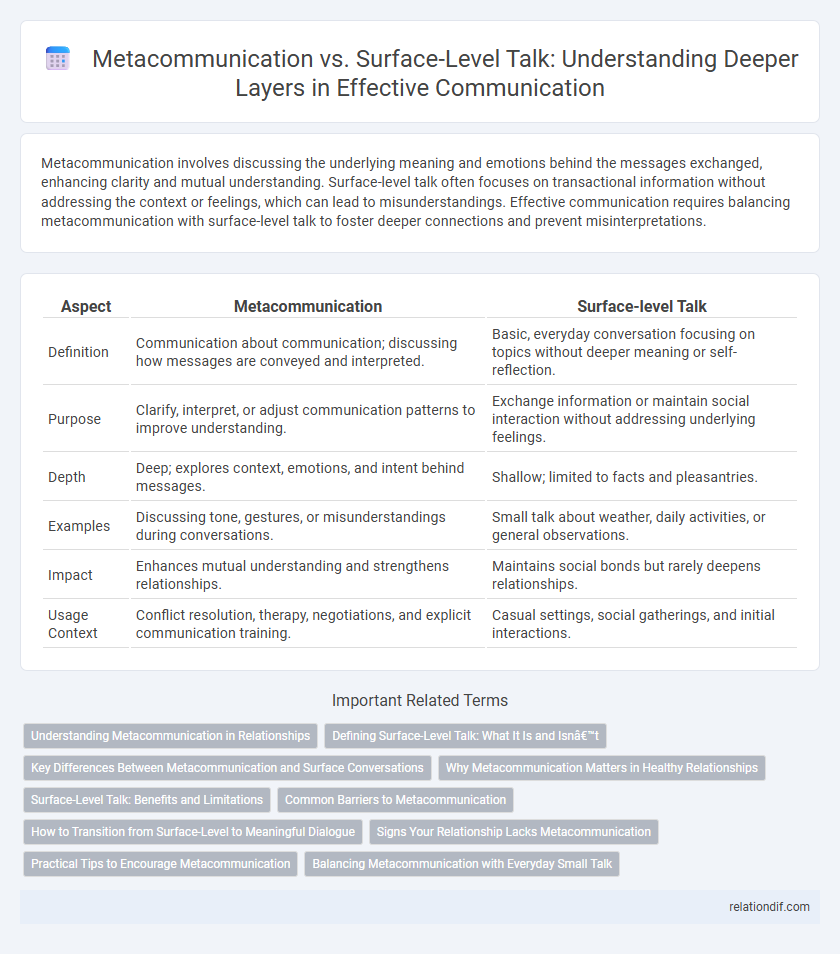Metacommunication involves discussing the underlying meaning and emotions behind the messages exchanged, enhancing clarity and mutual understanding. Surface-level talk often focuses on transactional information without addressing the context or feelings, which can lead to misunderstandings. Effective communication requires balancing metacommunication with surface-level talk to foster deeper connections and prevent misinterpretations.
Table of Comparison
| Aspect | Metacommunication | Surface-level Talk |
|---|---|---|
| Definition | Communication about communication; discussing how messages are conveyed and interpreted. | Basic, everyday conversation focusing on topics without deeper meaning or self-reflection. |
| Purpose | Clarify, interpret, or adjust communication patterns to improve understanding. | Exchange information or maintain social interaction without addressing underlying feelings. |
| Depth | Deep; explores context, emotions, and intent behind messages. | Shallow; limited to facts and pleasantries. |
| Examples | Discussing tone, gestures, or misunderstandings during conversations. | Small talk about weather, daily activities, or general observations. |
| Impact | Enhances mutual understanding and strengthens relationships. | Maintains social bonds but rarely deepens relationships. |
| Usage Context | Conflict resolution, therapy, negotiations, and explicit communication training. | Casual settings, social gatherings, and initial interactions. |
Understanding Metacommunication in Relationships
Metacommunication in relationships involves discussing the underlying messages behind verbal exchanges, enhancing mutual understanding beyond surface-level talk. It addresses tone, body language, and unspoken cues, which helps clarify intent and emotions often missed in everyday conversations. Emphasizing metacommunication fosters deeper connection and reduces misunderstandings by aligning partners' perceptions and expectations.
Defining Surface-Level Talk: What It Is and Isn’t
Surface-level talk involves exchanging basic information or casual remarks without delving into underlying emotions or intentions, often serving as a social lubricant rather than a means for genuine connection. It is not synonymous with metacommunication, which explicitly addresses the communication process itself, clarifying meaning and relational dynamics. Understanding the distinction between surface-level talk and metacommunication is essential for improving communication effectiveness and fostering deeper interpersonal understanding.
Key Differences Between Metacommunication and Surface Conversations
Metacommunication involves discussing the communication process itself, enabling clarity and mutual understanding, while surface-level talk centers on exchanging information or social pleasantries without addressing underlying meanings. Metacommunication reveals emotions, intentions, and relational dynamics that surface conversations typically overlook, fostering deeper connection and conflict resolution. Key differences include the depth of interaction, the focus on process versus content, and the capacity to influence future communication patterns.
Why Metacommunication Matters in Healthy Relationships
Metacommunication enhances relationship clarity by addressing the underlying messages behind surface-level talk, reducing misunderstandings and fostering emotional intimacy. It enables partners to express feelings and intentions explicitly, facilitating conflict resolution and mutual trust. Prioritizing metacommunication cultivates a deeper connection, improving overall communication effectiveness and relationship satisfaction.
Surface-Level Talk: Benefits and Limitations
Surface-level talk facilitates quick exchanges and helps establish initial rapport by focusing on neutral, non-controversial topics, making social interactions more comfortable and less intimidating. It supports relationship building in professional settings by maintaining politeness and preventing conflicts, yet its limitations include a lack of depth and potential misunderstandings due to avoidance of true feelings. Balancing surface-level talk with deeper communication ensures both social ease and meaningful connection.
Common Barriers to Metacommunication
Common barriers to metacommunication include fear of vulnerability, lack of emotional awareness, and misunderstanding nonverbal cues, which hinder deeper dialogue beyond surface-level talk. Cultural differences and power imbalances often exacerbate these obstacles, creating misinterpretations and resistance to honest feedback. Effective metacommunication requires recognizing these barriers to foster transparency and enhance mutual understanding in conversations.
How to Transition from Surface-Level to Meaningful Dialogue
Shifting from surface-level talk to meaningful dialogue begins with recognizing and addressing the metacommunicative signals that shape conversations, such as tone, body language, and underlying emotions. Asking open-ended questions and expressing genuine curiosity encourages deeper understanding and invites participants to share their thoughts beyond superficial exchanges. Establishing a safe and respectful communication environment fosters trust, enabling more authentic and impactful interactions that strengthen relationships.
Signs Your Relationship Lacks Metacommunication
A relationship lacking metacommunication often exhibits repeated misunderstandings despite frequent conversations, signaling a disconnect in how partners discuss their communication processes. Surface-level talk dominates, with interactions focusing only on daily activities or logistics rather than expressing feelings or clarifying intentions. Signs include frequent conflicts without resolution, emotional distance, and an inability to address communication patterns constructively.
Practical Tips to Encourage Metacommunication
Encourage metacommunication by creating a safe space where all parties feel comfortable expressing thoughts about the communication process itself, not just the content. Use open-ended questions to explore feelings, intentions, and misunderstandings behind surface-level talk, fostering deeper understanding. Regularly reflect on conversational dynamics and clarify nonverbal cues to enhance transparency and connection.
Balancing Metacommunication with Everyday Small Talk
Balancing metacommunication with everyday small talk enhances relational depth while maintaining social ease. Metacommunication fosters clarity by addressing underlying feelings and intentions, preventing misunderstandings in conversations. Small talk builds rapport and comfort, serving as a foundation for more meaningful dialogue and emotional connection.
Metacommunication vs Surface-level talk Infographic

 relationdif.com
relationdif.com